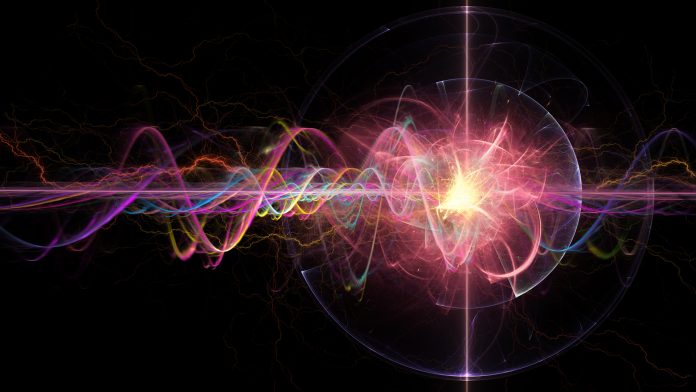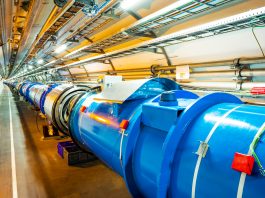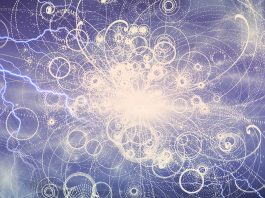Professor Bradley Cox from the University of Virginia outlines how teams from the US continue to be actively involved in cross-continental collaboration through experiments at CERN.
Many US high energy groups and US funding agencies have contributed in a substantial way to the CMS and the Atlas experiment, the two large experiments at CERN’s Large Hadron Collider (LHC). The cross-continental collaboration between universities, laboratory experimental groups, and funding agencies such as NSF and DOE are spread across the four LHC experiments: CMS, Atlas, LHCb, and Alice. In particular, the experiences of the US experimental groups in the CMS are typical of all US LHC experimental groups. They have contributed to all the elements of the CMS detector, including the CMS electromagnetic and hadronic calorimeters, muon detector, pixel and strip track detectors, trigger system, and detector electronics. The experiences and contributions of the University of Virginia (UVa) group in the LHC and CMS are presented here as typical of the contributions of these groups.
A difficult choice
By the 1990s, most US university and laboratory groups, including the UVa group, had spent 10 years of R&D and design for the Texas Supercollider effort until it was cancelled by the US Congress. At that point, many US groups interested in continuing experiments in truly frontier physics, while continuing their US programmes at Fermilab, Brookhaven, and the Stanford Linear Accelerator Laboratories, turned their attention to Geneva, Switzerland and the LHC collider programme that was just beginning in 1993. This choice was not taken easily since all the groups making this decision understood the difficulty of redirecting resources and mounting an experimental effort across 4,000 miles of ocean in a time zone six hours different. Eventually, however, over the next decade, four experiments were proposed and developed for the LHC known as Atlas, CMS, LHCb, and Alice. To some extent, these experiments mirrored efforts that had been planned for the Texas Supercollider.
Transition
The transition of effort by the University of Virginia HEP group to the LHC from the Texas Supercollider at this time was typical of many other of the US groups and, as such, gives a good idea of the experiences and successes that the US groups have experienced at the LHC. From 1993 to 2008, in order to participate in the CMS experiment at the LHC the UVa group (like many other US institutions) had to maintain cross-continental collaboration for the significant time that it took for the LHC accelerator construction to be finished and for first collisions to be initiated in 2010. In that time period, the four detectors for the four planned experiments were being prepared, and the UVa group, like other US groups, was heavily invested in the detector design and construction.
Like other US groups, the UVa group’s choice of concentration on a given aspect of the CMS detector construction was a combination of their previous detector experience, their capabilities, and the opportunities that a particular detector element gave them to contribute to a particular kind of physics. In the case of UVa, the group determined its best fit to be in the CMS experiment and it therefore moved to become a part of it. In particular, the UVa group decided to participate in the development of the approximately 74,000 element Lead Tungstate PbWO4, electromagnetic barrel, and endcap calorimeter, as well as the CMS’s hadronic endcap calorimeter.
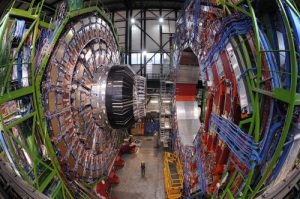
The Higgs boson
This decision was a product of the calorimetry expertise of the group that had long been involved in developing electromagnetic calorimetry in various Fermilab experiments for the detection of photons and electrons. It was becoming realised even at this early stage of the LHC that the primary detection mode for the long sought-after Higgs particle would be the Higgs decay into two photons. In spite of the low branching ratio for this decay, it presented the least background and most definitive signature of any of the other options for detection of the Higgs. The concentration on the CMS electromagnetic detector and the focus of the UVa group on photon detection gave the group a seat at the table for discussing the issues concerning the detection of the Higgs.
This was indeed a serendipitous situation for UVa: from the 2010 until the final announcement of the discovery of the Higgs particle on 4 July, 2012, members of the University of Virginia HEP group were asked to participate in a series of Analysis Review Committees (ARCS). The members of these ARCS were responsible for evaluating whether the di-photon data merited the claim of a discovery of the Higgs. Thus, the UVa group was on the ground floor of one of the major physics achievements of the 21st century.
By mid-summer of 2012, the di-photon system was observed to have an enhancement in its mass spectrum at approximately 125GeV/c2. That enhancement had a probability of less than one chance in 100,000 and, thus, was unlikely to be produced by an unfortunate and misleading fluctuation of statistics. However, to claim that this enhancement was a Higgs particle required confirmation of several features of the Higgs particle beyond just the simple observation of a bump in the di-photon system mass spectrum. This di-photon system had to be analysed to determine whether the signal was actually that of a spin zero scalar Higgs particle. Acorroborating observation of the same type signal from the Atlas detector which used very different technology to detect and measure their di-photon signal was also critical. Finally, different decay modes other than the di-photon decay, mainly the CMS and Atlas experiments, began to observe the four-electron Higgs decay at 125GeV/c2 mass. All of these factors allowed the CMS experiment in concert with the Atlas experiment to claim observation of the Higgs boson and so complete the search that was started by the High Energy Physics community in 1964.
Supersymmetry
Concurrent with their ARCS participation and their work on the Higgs data analysis, the UVa group continued its work on both sides of the Atlantic on improving the electromagnetic detector and investigating other frontier physics topics. These include searching for evidence of Supersymmetry which might resolve puzzles about why the mass of the Higgs (which gives mass to all other particles in Nature) is so low. It might also point to an entirely new constellation of particles as yet unseen in experiments.
Since the discovery of the Higgs particle, a large literature of studies of its nature (such as the aforementioned Supersymmetry searches) as well as searches for other Higgs-type particles have been conducted. Approximately a thousand journal papers have already been published or are in the process of being published on the LHC CMS data obtained at runs at energies from 3.5 to 13TeV. As successive runs have been accomplished, US institutions have continued to contribute to the detector maintenance and various detector improvements as well as performing on-going physics analyses at higher energies and higher statistics. The LHC is currently in a long period of shutdown, during which a major upgrade of all CMS detector systems and electronics is contemplated.
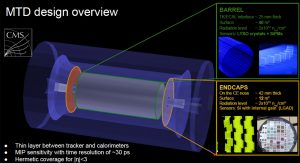
LHC upgrades
Thus, the US groups have been once again faced with a decision about which aspect of the upgrades of which detector element they should direct their efforts on. The UVa group has chosen to continue their support of the PbWO4 Lead Tungstate electromagnetic detector in the area of data transfer of digital signals from the calorimeter to the offline computing. In addition, the UVa group has committed to do the R&D necessary to develop and validate a new, novel timing capability for the CMS detector, a detector element that will measure the time of each of the approximately 200 interactions that take place in the two ns time interval of each proton-proton beam bunch crossing.
This timing detector will measure the time of each interaction with a resolution of better than 30ps by measuring the time of the passage of minimum ionising charged particles from the interactions as these charged particles pass through the material of the timing detector. Measuring the interaction time of particular interactions with interesting properties with a resolution of better than 30ps will eliminate background from the other 200 interactions and give additional information that will help in the analysis of the interesting interaction.
This new timing detector is composed of 350,000 to 500,000 LYSO crystal sensors of sizes of order 57mm x 2-3.5mm2 which produce blue light of wavelength approximately 350 nm when a minimum ionising track produced by the proton-proton interaction passes through the crystal. That light is detected by silicon photodetectors (SiPMs) positioned at the end of each LYSO bar. The time resolution of the CMS timing detector will slowly degrade over the lifetime of the detector because of the radiation damage to the silicon photosensors. The UVa group is active in testing these sensors to measure their properties and to verify that time resolutions of better than 30-50ps can be obtained over the lifetime of the detector, up to the full radiation exposure of 4,000 fb-1 at the end of life. It is also planned to study the electronics developed by Lisbon to ensure that these electronics can attain the timing resolution needed of the SiPM signals from the sensors. The signals from the Lisbon electronics will be tested in conjunction with the basic sensor performance so as to determine the resulting time resolution of the entire system.
Following the sensors and electronics R&D phase of the UVa activities, the plan is that UVa (along with Caltech and Milan) will prepare factories at their home institutions to each construct one third of the 350,000 to 500,000 sensors and sensor supports. These are to be shipped to CERN where the final cylindrical barrel detector will be assembled to provide the timing measurement of the central part of the CMS detector. The endcaps for the timing detector are being constructed by other participants in the CMS experiment.
Other universities and National Lab groups all over the world, and in particular in the US, are involved with various other upgrades of the existing CMS detector elements. While it is an overstatement that the CMS detector will truly be a completely different detector after the upgrade programme, enough features of the upgraded detector in 2024 will be changed so that the CMS detector will have greatly enhanced capabilities.
The Atlas, LHCb, and Alice experiments are undertaking similar upgrade programmes in parallel to that of the CMS experiment. It is expected that the upgrades will be finished by the middle of the 2020s, and the four CERN detectors will then be in operation.
Professor Bradley Cox
University of Virginia
+1 434 284 2860
bbc2x@virginia.edu
www.phys.virginia.edu/
Please note, this article will also appear in the second edition of our new quarterly publication.

